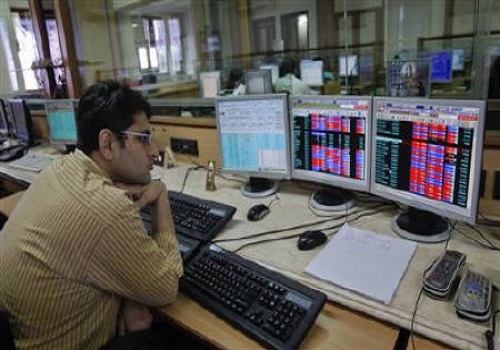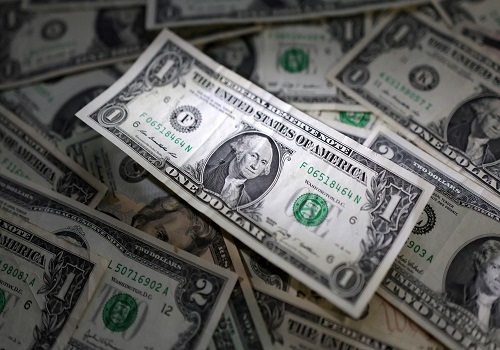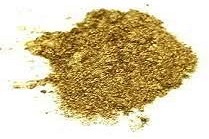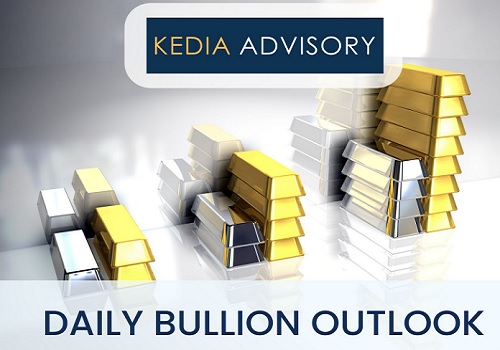Gold trading range for the day is 83430-85350 - Kedia Advisory

Gold
Gold settled down by 0.15% at Rs.84,444, pressured by a stronger dollar, though safe-haven demand remained intact amid geopolitical tensions and economic uncertainty. Weaker-than-expected U.S. services sector data fueled expectations of two Federal Reserve rate cuts in 2024, aligning with the latest FOMC projections. Meanwhile, ECB and BoC cut rates, with the BoC also ending quantitative tightening, while RBI and BoE are expected to follow suit this week. Gold’s safe-haven appeal received a boost after Donald Trump’s tariff threats, potential U.S. control over Gaza, and renewed interest in an Iran nuclear deal raised geopolitical concerns. Additionally, worries over global economic growth due to the U.S.-China trade conflict further supported gold prices. However, record-high prices dampened physical demand in India, where dealers continued to offer discounts of up to $35 per ounce. In Japan, bullion traded between a $3.5 discount and a $1 premium, while trading activity in China and Hong Kong remained muted due to the Lunar New Year holiday. The World Gold Council (WGC) expects India’s gold demand in 2025 to moderate from last year’s nine-year high of 802.8 metric tons, with projected demand between 700-800 metric tons. While jewelry demand may decline, investment demand remains strong, particularly in ETFs, digital gold, and coins & bars. Technically, gold is under long liquidation, with open interest dropping 4.14% to 17,126 contracts. Support is at Rs.83,935, with a break below testing Rs.83,430. Resistance is at Rs.84,895, and a move above could see Rs.85,350.
Trading Ideas:
* Gold trading range for the day is 83430-85350.
* Gold fell off a record high early as the dollar moved higher, though safe-haven demand amid Donald Trump's tariff threats continue to support.
* US data showed weaker-than-expected demand for services, suggesting economic activity could moderate in the coming months.
* Gold’s safety appeal was further bolstered after Trump suggested the US could take control of Gaza.
Silver
Silver settled down by 0.39% at Rs.95,588, pressured by a stronger dollar as traders assessed the U.S. economic and monetary outlook. Treasury Secretary Scott Bessent emphasized 10-year Treasury yields over Fed rates as a key focus for lowering borrowing costs. While President Trump is not pressuring the Fed for rate cuts, markets still expect two 25bps cuts in 2025. Meanwhile, Chicago Fed President Austan Goolsbee cautioned about inflationary risks from tariffs, drawing parallels to COVID-era supply disruptions. Investors now await the U.S. jobs report for further labor market insights. Despite recent declines, silver remains supported by strong industrial demand, with the market expected to face its fifth consecutive year of deficit in 2025. Global silver demand is forecast at 1.20 billion ounces, driven by record-high industrial fabrication demand, expected to grow by 3% and surpass 700 Moz for the first time. However, jewelry demand is set to decline by 6%, mainly due to India's high domestic prices, leading to a double-digit drop. On the supply side, silver mine production is expected to hit a seven-year high of 844 Moz, while silver recycling is projected to rise by 5%, exceeding 200 Moz for the first time since 2012. Technically, silver is under long liquidation, with open interest falling 6.19% to 23,620 contracts. Support is at Rs.94,760, with a break below testing Rs.93,935. Resistance is at Rs.96,100, and a move above could push prices towards Rs.96,615.
Trading Ideas:
* Silver trading range for the day is 93935-96615.
* Silver dropped as dollar index edged up to 108 as traders evaluated the US economic and monetary outlook.
* Treasury Secretary Bessent said that the Trump administration prioritizes 10-year Treasury yields over the Federal Reserve’s interest rate.
* Fed's Goolsbee warns of potential inflationary impact of tariffs
Crude Oil
Crude oil settled down by 0.32% at Rs.6,210, after President Trump reaffirmed plans to boost US oil production to drive crude prices lower. However, Saudi Arabia's state oil company raised its March crude prices sharply. This was driven by rising demand from China and India and disruptions to Russian supply due to US sanctions. Additionally, President Trump’s renewed push to eliminate Iran’s oil exports threatens to remove 1.5 million barrels per day from the market, adding to supply risks. However, oil prices came under pressure after the EIA reported an 8.7 million-barrel surge in U.S. crude stocks, marking the largest build in nearly a year. U.S.-China trade tensions also weighed on sentiment, with China imposing tariffs on American coal, LNG, and crude oil, raising concerns about weaker global demand. According to the EIA's Short-Term Energy Outlook, global oil production growth is set to outpace demand over the next two years. The agency raised its U.S. oil production estimate to 13.55 million bpd, with the Permian Basin expected to contribute over half of total U.S. output by 2026. Meanwhile, global oil production is now expected to reach 104.4 million bpd in 2025, while demand is forecasted to average 104.1 million bpd, below pre-pandemic levels. Technically, crude oil is under long liquidation, with open interest dropping 1.04% to 8,672 contracts. Support is at Rs.6,170, with a break below testing Rs.6,131. Resistance is at Rs.6,278, and a move above could push prices towards Rs.6,347.
Trading Ideas:
* Crudeoil trading range for the day is 6131-6347.
* Crude oil dropped after President Trump reaffirmed plans to boost US oil production to drive crude prices lower.
* Additionally, supply risks persisted as President Trump’s renewed campaign seeks to eliminate Iran's oil exports
* U.S.-China trade tariffs cloud oil demand outlook
Natural Gas
Natural gas closed 3.54% higher at Rs.295.8, driven by forecasts of colder weather and increased heating demand over the next two weeks. Meteorologists predict below-normal temperatures from February 10-14, raising expectations for stronger consumption. Despite this, daily U.S. gas output increased to 106.2 bcfd in February, up from 102.7 bcfd in January, as production rebounded from freeze-offs that had disrupted supply. Additionally, gas flows to U.S. LNG export plants reached 14.9 bcfd, up from 14.6 bcfd in January, reflecting sustained export demand. The EIA reported a 174 bcf withdrawal from storage for the week ending January 31, exceeding market expectations of 168 bcf. This sharp draw was led by declines in the Midwest (-56 bcf), South Central (-47 bcf), and East (-45 bcf) regions. U.S. storage levels are now 8% lower than a year ago and 4.4% below the five-year average, adding support to prices. Looking ahead, the EIA expects record-high gas output and demand in 2025, forecasting 104.5 bcfd in production and 90.6 bcfd in consumption. LNG exports are also expected to surge to 14.1 bcfd in 2025 and 16.2 bcfd in 2026, up from a record 12.0 bcfd in 2024. Technically, natural gas is in fresh buying mode, with open interest surging 16.94% to 14,229 contracts. Support is at Rs.290.7, with a break below potentially testing Rs.285.6. Resistance is at Rs.299.7, and a move above could push prices towards Rs.303.6.
Trading Ideas:
* Naturalgas trading range for the day is 285.6-303.6.
* Natural gas edged up on forecasts for colder weather and higher heating demand.
* US utilities withdrew 174 billion cubic feet (bcf) of natural gas from storage.
* Storage levels are now 8% lower than the same period last year and 4.4% below the five-year average.
Copper
Copper settled 0.43% higher at Rs.854.65, supported by easing trade war fears as China responded with measured countermeasures to U.S. tariffs. Expectations of an upcoming call between U.S. President Donald Trump and Chinese President Xi Jinping raised hopes of de-escalation, which could potentially lead to tariff reversals. Further bolstering sentiment, positive manufacturing PMI data from both the U.S. and China signaled continued industrial expansion, strengthening demand prospects. On the supply side, Chile’s copper production rose 14.3% year-on-year in December to 566,547 metric tons, while Peru’s Las Bambas mine projects 400,000 metric tons output in 2025. However, Chile revised its long-term copper production forecast down to 5.54 million tons by 2034, compared to an earlier estimate of 6.34 million tons, hinting at future supply constraints. Antofagasta’s 2024 production grew just 1% to 664,000 metric tons, missing projections due to lower ore grades. The global refined copper market showed a significant 131,000 metric ton deficit in November, widening from 30,000 metric tons in October, according to the ICSG. However, for the first 11 months of 2023, the market remained in a surplus of 168,000 metric tons, contrasting with a deficit of 89,000 metric tons a year earlier. Additionally, China’s imports of unwrought copper surged 17.8% YoY in December, reflecting strong demand. Technically, copper is experiencing short covering, with open interest dropping 2.17% to 6,217 contracts. Support is at Rs.850.5, with a potential test at Rs.846.1, while resistance stands at Rs.859.6, and a break above may push prices to Rs.864.3.
Trading Ideas:
* Copper trading range for the day is 846.1-864.3.
* Copper rose driven by and easing concerns over a global trade war.
* Positive manufacturing PMI data from both the US and China, two of the world’s largest economies, also pointed to ongoing expansion.
* However, treatment charges in Chinese copper smelters continued to reflect uncertainty about future demand levels.
Zinc
Zinc settled 0.77% higher at Rs.269.35, supported by easing trade war concerns after U.S. President Donald Trump delayed tariffs on Canada and Mexico while China responded mildly to Washington’s levies. Supply constraints also played a crucial role, as global mined zinc production fell for the third consecutive year in 2024, with China’s refined zinc output dropping 7% due to lower processing rates. Additionally, output from Alaska’s Red Dog Mine—the world’s largest zinc mine—is set to slow in 2025, further tightening supply. Inventory levels continued to shrink, with LME-registered zinc stocks at their lowest since February 2024, signaling strong demand despite macroeconomic uncertainties. Still, investors remain hopeful that China’s National People’s Congress meeting in March could introduce new stimulus measures to support industrial growth. The global zinc market showed a 52,900 metric ton deficit in November, narrowing from 65,400 metric tons in October, according to ILZSG data. For the first 11 months of 2024, the market ran a 33,000 metric ton deficit, a sharp contrast from the 312,000 metric ton surplus in 2023. Meanwhile, China’s refined zinc production in January 2025 rose 1% MoM but fell nearly 8% YoY, with expectations of an 8% MoM decline in February due to holiday shutdowns and maintenance. Technically, zinc is in short covering mode, with open interest dropping 7.47% to 2,986 contracts. Support is at Rs.267.9, with a possible test at Rs.266.5, while resistance stands at Rs.270.9, and a move above could push prices toward Rs.272.5.
Trading Ideas:
* Zinc trading range for the day is 266.5-272.5.
* Zinc rose as fears about a full-blown trade war eased despite threats by U.S. President Donald Trump.
* Global mined zinc production fell for the third consecutive year in 2024.
* Investors are hoping China will unleash more stimulus at its National People's Congress meeting in March.
Aluminium
Aluminium settled 0.39% higher at Rs.255.95, supported by supply concerns and improving manufacturing indicators. China produced a record 44 million metric tons of aluminium in 2024, but further growth is expected to slow due to Beijing's 45 million-ton cap on annual output, aimed at controlling excess supply and reducing carbon emissions. Meanwhile, the European Union’s plan to gradually ban Russian aluminium imports has added uncertainty to supply chains, although a one-year phase-in period with exemptions for 275,000 metric tons has been proposed. On the macroeconomic front, China's aluminium consumption is expected to recover as production resumes post-Lunar New Year. However, U.S.-China trade tensions have intensified, with Trump imposing a 10% tariff on Chinese goods, prompting China to file a WTO complaint and announce potential countermeasures. Global primary aluminium output in December increased 3% YoY to 6.236 million metric tons, according to the International Aluminium Institute (IAI). In China, December production rose 4.2% YoY to 3.77 million metric tons, with daily output declining 1.7% from November. However, higher costs pushed average industry profits into losses for the first time in three years, with Chinese aluminium producers losing an average of 687 yuan per ton, per Antaike Research. Technically, aluminium remains in a fresh buying phase, with open interest rising 7.2% to 4,302 contracts. Support is at Rs.254.8, with a possible test at Rs.253.6, while resistance stands at Rs.257.2, and a move above could drive prices towards Rs.258.4.
Trading Ideas:
* Aluminium trading range for the day is 253.6-258.4.
* Aluminium gained as supply concerns and strong leading indicators for manufacturers improved the outlook.
* European Union's plan to gradually ban Russian aluminum imports has sparked concerns.
* Global primary aluminium output in December rose 3% year on year to 6.236 million tonnes.
Cottoncandy
Cottoncandy fell by 0.24% to Rs.53,700, pressured by increased crop projections by the Cotton Association of India (CAI) and the USDA’s WASDE report, which forecast higher global production and ending stocks for 2024-25. CAI raised India’s cotton production estimates by 2 lakh bales to 304.25 lakh bales, mainly due to a 6 lakh bales increase in Telangana’s output. Meanwhile, North India’s production is expected to decline by 3.5 lakh bales, while cotton arrivals in Punjab, Haryana, and Rajasthan are down 43% year-on-year, causing supply concerns. Global factors also weighed on sentiment, with Brazil’s 2024-25 cotton forecast revised down to 3.79 million tonnes due to lower acreage in Mato Grosso. The USDA projects global production to increase by 1.2 million bales to 117.4 million bales, driven by higher production in India and Argentina. However, strong demand from South Indian garment industries and export orders is limiting the downside. India’s cotton consumption for 2024-25 has been revised up by 2 lakh bales to 315 lakh bales, reflecting strong demand from textile industries. As of January 22, cumulative market arrivals stood at over 156 lakh bales, surpassing half of the estimated crop size. In Rajkot’s spot market, cotton prices declined 0.18% to Rs.25,224.9 per bale. Technically, the market is under fresh selling, with open interest rising 0.39% to 260 contracts. Support is seen at Rs.53,700, with a further test possible at the same level, while resistance is at Rs.53,700, and a breakout could push prices towards Rs.53,700.
Trading Ideas:
* Cottoncandy trading range for the day is 53700-53700.
* Cotton dropped as CAI has revised upwards its crop projections by 2 lakh bales from its earlier estimates.
* Brazil's 2024-25 cotton production forecast was revised down to 3.79 million tonnes.
* Global cotton production is projected to rise by more than 1.2 million bales to 117.4 million bales.
* In Rajkot, a major spot market, the price ended at 25224.9 Rupees dropped by -0.18 percent.
Turmeric
Turmeric rose by 1.93% to settle at 13,552, driven by expectations of a 10-15% decline in new crop yields, particularly in Nanded, where small rhizomes and crop rots have been reported. Farmers remain cautious about the final yield, and confirmation of losses will be clearer once harvesting picks up in key producing regions. Despite these supply concerns, weak demand and an increase in arrivals have limited further price gains. With harvesting progressing well, the market expects maximum crop arrivals within a month, which could weigh on prices in the near term. Spot market arrivals jumped to 13,190 bags from 6,780 bags, with higher supplies in Nizamabad and Hingoli contributing to market pressure. Turmeric exports from April to November 2024 surged 9.80% to 121,601.21 tonnes compared to 110,745.34 tonnes in the same period in 2023. However, November 2024 exports fell 20.18% month-on-month to 12,721.25 tonnes from 15,938.21 tonnes in October 2024. Compared to November 2023, exports surged 48.22%. Meanwhile, turmeric imports rose sharply by 101.80% in April-November 2024, reaching 18,937.95 tonnes, though November imports dropped 34.84% month-on-month. Technically, the market is witnessing fresh buying, with open interest rising by 0.12% to 12,190 contracts. Support is at 13,402, and a break below this could test 13,254 levels. On the upside, resistance is at 13,642, and a move above this may push prices toward 13,734.
Trading Ideas:
* Turmeric trading range for the day is 13254-13734.
* Turmeric gains as new crop yields are expected to be 10-15% lower this year.
* Support also seen amid concerns over slow growth of rhizomes and low yield estimates persist.
* With the arrival of new crop likely to increase after Makar Sankranti, supply is expected to increase.
* In Nizamabad, a major spot market, the price ended at 13161.25 Rupees dropped by -1.43 percent.
Jeera
Jeera declined by 0.93% to settle at Rs.20,715, as demand remains subdued while exports are being fulfilled from existing stocks. Farmers still hold around 20 lakh bags of cumin, but only 3-4 lakh bags are expected to be traded before the season ends, leaving a carry-forward stock of 16 lakh bags. The current production levels are anticipated to match last year’s, supported by favorable crop conditions and good sowing activity. However, the downside is limited due to tightening stock availability. India’s cumin seed production increased to 8.6 lakh tonnes over 11.87 lakh hectares in 2023-24, compared to 5.77 lakh tonnes over 9.37 lakh hectares in the previous year, as per Spices Board data. Indian cumin remains the cheapest in the global market, making it the preferred choice for international buyers, including China. Currently, Indian cumin is priced at $3,050 per tonne, which is $200–$250 lower than Chinese cumin, increasing its competitiveness. Jeera exports surged 74.04% during April–November 2024, reaching 147,006.20 tonnes, compared to 84,467.16 tonnes in the same period in 2023. However, November 2024 exports declined 28.92% month-on-month to 11,555.56 tonnes from 16,257.44 tonnes in October 2024, but remained 42.67% higher year-on-year. Technically, the market is under long liquidation, with open interest dropping 0.69% to 2,604 contracts. Support is at Rs.20,660, and a break below may test Rs.20,590. On the upside, resistance is at Rs.20,840, and a move above this could push prices toward Rs.20,950.
Trading Ideas:
* Jeera trading range for the day is 20590-20950.
* Jeera dropped as demand is low and the current export business is being met from the available stock.
* However, only 3-4 lakh bags are expected to be traded by the end of the season, leaving a carry-forward stock of about 16 lakh bags.
* The current season is expected to have similar production levels as last year due to better crop conditions and good sowing.
* In Unjha, a major spot market, the price ended at 21166.75 Rupees dropped by -0.06 percent.
Views express by all participants are for information & academic purpose only. Kindly read disclaimer before referring below views





.jpg)
















